Copyright Protection of 3D Digitized Artistic Sculptures by Adding Unique Local Inconspicuous Errors by Sculptors
Abstract
:1. Introduction
1.1. Photogrammetry
1.2. 3D Scanning
2. Related Works
3. Materials and Methods
3.1. Proposed Algorithm
3.2. Digitization Process
3.2.1. Photogrammetry Surveying
3.2.2. 3D Digitization by Fringe Projection Scanner
4. Results
4.1. Comparison of the Geometry of Models Obtained by Scanning in MeshLab Software
4.2. Comparison of Model Geometry Obtained by Photogrammetry and Scanning in CloudCompare Software
4.2.1. The Original and the Model with Error Obtained by Photogrammetry
4.2.2. The Original and the Model with Error Obtained by Scanning
4.2.3. Comparison of Original Models Obtained by Scanning and Photogrammetry
4.2.4. Comparison of the Model with Digital Error Obtained by Scanning and by Photogrammetry
4.3. Survey on the Geometric Similarity of Sculptures
- 1.
- Are there two identical sculptures? a. Yes, b. No
- 2.
- If you answered Yes on question 1, list the appropriate pairs:a. 1 and 2 b. 1 and 3 c. 1 and 4 d. 2 and 3 e. 2 and 4 f. 3 and 4
- 3.
- If there are no sculptures that are the same, which pair of sculptures is the most similar:a. 1 and 2 b. 1 and 3 c. 1 and 4 d. 2 and 3 e. 2 and 4 f. 3 and 4
- 4.
- Which sculpture(s) differs the most from the sculpture marked number 1?a. 2 b. 3 c. 4
- 5.
- If you mentioned sculpture 2 in the previous answer (Question 4), list the parts of the face on sculpture 2 that are different from sculpture 1:a. Beard b. Mouth/Lips c. Nosed. Left cheekbone e. Right cheekbone f. Left eyeg. Right eye h. Lower jaw bone i. Arcade/protrusion of the frontal bone on the left sidej. Arcade/protrusion of the frontal bone on the right side k. Forehead l. Hairm. Earlobe on left ear n. Earlobe on right ear o. Left earp. Right ear
- 6.
- If you mentioned sculpture 3 in the previous answer (Question 4), list the parts of the face on sculpture 3 that are different from sculpture 1:The answers offered are the same as for Question 5.
- 7.
- If you mentioned sculpture 4 in the previous answer (Question 4), list the parts of the face on sculpture 4 that are different from sculpture 1:The answers offered are the same as for question 5.
4.4. Digital Protection Extraction
5. Discussion
6. Conclusions
- -
- Using a haptic hand for digital sculpting. With this device, the sculptor would sculpt on a 3D model that is digital and avoid contact with the original work of art. In this way, we could add a digital error without contact with the original physical model. This would reduce the execution time, i.e., it would be necessary to digitize only the original work (piece of art), not the work with built-in physical error.
- -
- Determining reference positions for adding a digital error to characters of different years/ages or sex.
- -
- In this paper, we have limited ourselves to sculpture because we wanted to analyze and confirm that our idea and approach lead to valid results. It is certainly possible to apply the procedure to other types of artifacts, such as coins, pottery, or architectural objects.
Author Contributions
Funding
Institutional Review Board Statement
Informed Consent Statement
Data Availability Statement
Acknowledgments
Conflicts of Interest
References
- Djuric, I.; Stojakovic, V.; Misic, S.; Kekeljevic, I.; Vasiljevic, I.; Obradovic, M.; Obradovic, R. Church Heritage Multimedia Presentation-Case study of the iconostasis as the characteristic art and architectural element of the Christian Orthodox churches. Architecture in the Age of the 4th Industrial Revolution. In Proceedings of the 37th eCAADe and 23rd SIGraDi Conference, University of Porto, Porto, Portugal, 11–13 September 2019; Volume 1, pp. 551–560. [Google Scholar] [CrossRef]
- Koller, D. Protected sharing of 3D models of cultural heritage and archaeological artifacts. In Proceedings of the 36th CAA Conference, Budapest, Hungary, 2–6 April 2008; Volume 2, pp. 326–331. [Google Scholar]
- Obradović, R.; Stojaković, V.; Đurić, I.; Vasiljević, I.; Kekeljević, I.; Obradović, M. 3D Digitalization and AR Presentation of the Iconostasis of the Church of St. Procopius the Great Martyr in Srpska Crnja. In Exhibition Catalogue Đura Jakšić. Between Myth and Reality; Gallery of Matica Srpska: Novi Sad, Serbia, April 2019; ISBN 978-8-80706-27-6. Available online: http://www.racunarska-grafika.com/srpska-crnja/ (accessed on 3 April 2021).
- Obradović, R.; Stojaković, V.; Đurić, I.; Vasiljević, I.; Kekeljević, I.; Obradović, M. In the Exhibition Catalogue Kračun. Gallery of Matica Srpska: Novi Sad, Serbia, October 2019. Available online: http://racunarska-grafika.com/mitrovica/ (accessed on 3 April 2021).
- Obradović, R.; Stojaković, V.; Đurić, I.; Vasiljević, I.; Kekeljević, I.; Obradović, M. In the Exhibition Catalogue Kračun. Gallery of Matica Srpska: Novi Sad, Serbia, October 2019. Available online: http://racunarska-grafika.com/karlovci/ (accessed on 3 April 2021).
- Stojaković, V.; Obradović, R.; Đurić, I.; Vasiljević, I.; Obradović, M.; Kićanović, J. Strategy Development for Standardization of Creation of Photogrammetric 3D Digital Objects of Cultural Heritage—Phase, I. In Project Report; Projects for Digitization of Cultural Heritage of the Republic of Serbia, Ministry of Culture and Information of the Republic of Serbia; Faculty of Technical Sciences, University of Novi Sad: Novi Sad, Serbia, 2020; Available online: http://www.muzejvojvodine.org.rs/images/Rimsko%20nasledje%20u%203D/index.html (accessed on 3 April 2021).
- Obradović, M.; Vasiljević, I.; Đurić, I.; Kićanović, J.; Stojaković, V.; Obradović, R. Virtual Reality Models Based on Photogrammetric Surveys—A Case Study of the Iconostasis of the Serbian Orthodox Cathedral Church of Saint Nicholas in Sremski Karlovci (Serbia). Appl. Sci. 2020, 10, 2743. [Google Scholar] [CrossRef]
- Liu, Q.; Safavi-Naini, R.; Sheppard, N.P. Digital rights management for content distribution. In Proceedings of the Australasian Information Security Workshop Conference on ACSW Frontiers 2003, Adelaide, Australia, 1 February 2003; Volume 21, pp. 49–58. [Google Scholar]
- Evens, T.; Hauttekeete, L. Challenges of digital preservation for cultural heritage institutions. J. Libr. Inf. Sci. 2011, 43, 157–165. [Google Scholar] [CrossRef]
- Fruehauf, J.D.; Hartle, F.X.; Al-Khalifa, F. 3D printing: The future crime of the present. In Proceedings of the Conference on Information Systems Applied Research, Washington, DC, USA, 3–6 November 2021. [Google Scholar]
- Borissova, V. Cultural heritage digitization and related intellectual property issues. J. Cult. Herit. 2018, 34, 145–150. [Google Scholar] [CrossRef]
- Trencheva, T.; Zdravkova, E. Intellectual Property Management in Digitization and Digital Preservation of Cultural Heritage. EDULEARN19 Proc. 2019, 10, 6082–6087. [Google Scholar]
- Manžuch, Z. Ethical issues in digitization of cultural heritage. J. Contemp. Arch. Stud. 2017, 4, 1–17. [Google Scholar]
- Ohbuchi, R.; Masuda, H.; Aono, M. Watermarking three-dimensional polygonal models through geometric and topological modifications. IEEE J. Sel. Areas Commun. 1998, 16, 551–560. [Google Scholar] [CrossRef]
- Ohbuchi, R.; Masuda, H.; Aono, M. Embedding data in 3D models. In International Workshop on Interactive Distributed Multimedia Systems and Telecommunication Services; Springer: Berlin/Heidelberg, Germany, 1997; pp. 1–10. [Google Scholar]
- Koller, D.; Frischer, B.; Humphreys, G. Research challenges for digital archives of 3D cultural heritage models. J. Comput. Cult. Herit. 2009, 2, 1–17. [Google Scholar] [CrossRef]
- Levoy, M.; Pulli, K.; Curless, B.; Rusinkiewicz, S.; Koller, D.; Pereira, L.; Ginzton, M.; Anderson, S.; Davis, J.; Ginsberg, J.; et al. The digital Michelangelo project. In Proceedings of the ACM SIGGRAPH International Conference on Computer Graphics and Interactive Techniques, New Orleans, LA, USA, 23–28 July 2000; pp. 131–144. [Google Scholar] [CrossRef]
- Koller, D.; Trimble, J.; Najbjerg, T.; Gelfand, N.; Levoy, M. Fragments of the city: Stanford’s digital forma urbisromae project. In Proceedings of the Third Williams Symposium on Classical Architecture, Rome, Italy, 20–23 March 2006; Volume 61, pp. 237–252. [Google Scholar]
- Frischer, B.; Abernathy, D.; Giuliani, F.C.; Scott, R.; Ziemssen, H. A new digital model of the roman forum. J. Roman Arch. 2006, 61, 163–182. [Google Scholar]
- Pham, G.N.; Lee, S.-H.; Kwon, O.-H.; Kwon, K.-R. A Watermarking Method for 3D Printing Based on Menger Curvature and K-Mean Clustering. Symmetry 2018, 10, 97. [Google Scholar] [CrossRef] [Green Version]
- Tran, T.V. 3D Printing Watermarking Algorithm Based on 2D Slice Mean Distance. Int. J. Adv. Trends Comput. Sci. Eng. 2020, 9, 57–64. [Google Scholar] [CrossRef]
- Praun, E.; Hoppe, H.; Finkelstein, A. Robust mesh watermarking. In Proceedings of the 26th Annual Conference on Computer Graphics and Interactive Techniques, Los Angeles, CA, USA, 1 July 1999; pp. 49–56. [Google Scholar] [CrossRef] [Green Version]
- Wu, H.T.; Cheung, Y.M. A fragile watermarking scheme for 3D meshes. In Proceedings of the 7th Workshop on Multimedia and Security, New York, NY, USA, 1–2 August 2005; pp. 117–124. [Google Scholar] [CrossRef] [Green Version]
- Ben Amar, Y.; Trabelsi, I.; Dey, N.; Bouhlel, S. Euclidean Distance Distortion Based Robust and Blind Mesh Watermarking. Int. J. Interact. Multimed. Artif. Intell. 2016, 4, 46. [Google Scholar] [CrossRef] [Green Version]
- Nakazawa, S.; Kasahara, S.; Takahashi, S. A visually enhanced approach to watermarking 3D models. In Proceedings of the 2010 Sixth International Conference on Intelligent Information Hiding and Multimedia Signal Processing, Darmstadt, Germany, 15–17 October 2010; pp. 110–113. [Google Scholar] [CrossRef]
- Cho, J.-W.; Prost, R.; Jung, H.-Y. An Oblivious Watermarking for 3-D Polygonal Meshes Using Distribution of Vertex Norms. IEEE Trans. Signal Process. 2006, 55, 142–155. [Google Scholar] [CrossRef] [Green Version]
- Botta, M.; Cavagnino, D.; Gribaudo, M.; Piazzolla, P. Fragile Watermarking of 3D Models in a Transformed Domain. Appl. Sci. 2020, 10, 3244. [Google Scholar] [CrossRef]
- Cox, I.; Miller, M.; Bloom, J.; Fridrich, J.; Kalker, T. Digital Watermarking and Steganography; Morgan Kaufmann: San Francisco, CA, USA, 2007. [Google Scholar]
- Wang, K.; Lavoué, G.; Denis, F.; Baskurt, A. Robust and blind mesh watermarking based on volume moments. Comput. Graph. 2011, 35, 1–19. [Google Scholar] [CrossRef]
- Hu, R.; Xie, L.; Yu, H.; Ding, B. Applying 3D Polygonal Mesh Watermarking for Transmission Security Protection through Sensor Networks. Math. Probl. Eng. 2014, 2014, 1–12. [Google Scholar] [CrossRef] [PubMed] [Green Version]
- Nocerino, E.; Lago, F.; Morabito, D.; Remondino, F.; Porzi, L.; Poiesi, F.; Eisert, P. A smartphone-based 3D pipeline for the creative industry-the replicate EU project. 3D Virtual Reconstr. Vis. Complex Archit. 2017, 42, 535–541. [Google Scholar] [CrossRef] [Green Version]
- Remondino, F.; Del Pizzo, S.; Kersten, T.P.; Troisi, S. Low-cost and open-source solutions for automated image orientation–A critical overview. In Euro-Mediterranean Conference; Springer: Berlin/Heidelberg, Germany, 2012; pp. 40–54. [Google Scholar]
- Schöning, J.; Heidemann, G. Evaluation of multi-view 3D reconstruction software. In International Conference on Computer Analysis of Images and Patterns; Springer: Cham, Switzerland, 2015; pp. 450–461. [Google Scholar]
- Stathopoulou, E.K.; Welponer, M.; Remondino, F. Open-Source Image-Based 3d Reconstruction Pipelines: Review, Comparison and Evaluation. In The International Archives of Photogrammetry, Remote Sensing and Spatial Information Sciences, 42. In Proceedings of the 6th International Workshop LowCost 3D—Sensors, Algorithms, Applications, Strasbourg, France, 2–3 December 2019; Volume XLII-2/W17, pp. 331–338. [Google Scholar] [CrossRef] [Green Version]
- Rahaman, H.; Champion, E. To 3D or Not 3D: Choosing a Photogrammetry Workflow for Cultural Heritage Groups. Heritage 2019, 2, 112. [Google Scholar] [CrossRef] [Green Version]
- González-Aguilera, D.; López-Fernández, L.; Rodriguez-Gonzalvez, P.; Guerrero, D.; Hernandez-Lopez, D.; Remondino, F.; Menna, F.; Nocerino, E.; Toschi, I.; Ballabeni, A.; et al. Development of an All-Purpose Free Photogrammetric Tool. Int. Arch. Photogramm. Remote Sens. Spat. Inf. Sci. 2016, XLI-B6, 31–38. [Google Scholar] [CrossRef] [Green Version]
- Remondino, F.; El-Hakim, S. Image-based 3D modelling: A review. Photogramm. Rec. 2006, 21, 269–291. [Google Scholar] [CrossRef]
- Abed, F.M.; Mohammed, M.U.; Kadhim, S.J. Architectural and Cultural Heritage conservation using low-cost cameras. Appl. Res. J. 2017, 3, 376–384. [Google Scholar]
- Santoši, Ž.; Šokac, M.; Korolija-Crkvenjakov, D.; Kosec, B.; Soković, M.; Budak, I. Reconstruction of 3D models of cast sculptures using close-range photogrammetry. Metalurgija 2015, 54, 695–698. [Google Scholar]
- Mara, H.; Portl, J. Acquisition and documentation of vessels using highresolution3D-scanners. In Corpus Vasorum Antuorum; Verlag der Österreichischen Akademie der Wissenschaften (VÖAW): Vienna, Austria, 2013; pp. 25–40. [Google Scholar]
- Montusiewicz, J.; Barszcz, M.; Dziedzic, K. Photorealistic 3D Digital Reconstructionof a Clay Pitcher. Adv. Sci. Tech. Res. J. 2019, 13, 255–263. [Google Scholar] [CrossRef]
- Spelitz, S.; de Almeida, M.V.; Lang-Auinger, C. Automatic geometry, metrology, and visualisation techniques for 3D scanned vessels. Digit. Appl. Archaeol. Cult. Herit. 2019, 17, e00105. [Google Scholar] [CrossRef]
- Arbacea, L.; Sonninob, E.; Callieri, M.; Dellepianec, M.; Fabbrid, M.; Idelsone, A.I.; Scopignoc, R. Innovative uses of 3D digital technologies toassist the restoration of a fragmented terracotta statue. J. Cult. Herit. 2013, 14, 332–345. [Google Scholar] [CrossRef]
- Barsanti, S.G.; Guidi, G. 3D digitization of museum content within the3dicons project. In ISPRS Annals of the Photogrammetry, RemoteSensing and Spatial Information Sciences. In Proceedings of the XXIV International CIPA Symposium, Strasbourg, France, 2–6 September 2013; Volume II-5/W1, pp. 151–156. [Google Scholar]
- Jo, Y.H.; Hong, S.; Jo, S.Y.; Kwon, Y.M. Noncontact restoration of missing parts ofstone Buddha statue based on three-dimensional virtual modelingand assembly simulation. Herit. Sci. 2020, 8, 1–12. [Google Scholar] [CrossRef]
- Giuffrida, D.; Nardo, V.M.; Adinolfi, O.; Mastelloni, M.A.; Ponterio, R.C. A theatricaldouble-faced mask preserved at the museum of lipari (messina): Study and 3d reconstruction through portable equipment. Virtual. Archaeol. Rev. 2021, 12, 39–48. [Google Scholar] [CrossRef]
- Dawson, P.C.; Levy, R.M.; Oetelaar, G.; Arnold, C.; Lacroix, D.; Macka, G. Documenting mackenzie inuit architecture using 3D laser scanning. Alaska J. Anthropol. 2009, 7, 29–44. [Google Scholar]
- Milosz, M.; Skulimowski, S.; Kęsik, J.; Montusiewicz, J. Virtual and interactivemuseum of archaeological artefacts from Afrasiyab—An ancientcity on the silk road. Digit. Appl. Arch. Cult. Herit. 2020, 18, 1–12. [Google Scholar]
- Dell’Unto, N.; Leander, A.M.; Ferdani, D.; Dellepiane, M.; Callieri, M.; Lindgren, S. Digital reconstruction and visualization in archaeology. Case-studydrawn from the work of the Swedish Pompeii Project. In Proceedings of the DigitalHeritage International Congress, Marseille, France, 28 October–1 November 2013; pp. 621–628. [Google Scholar] [CrossRef]
- Guidi, G.; Russo, M.; Angheleddu, D. 3D survey and virtual reconstructionof archeological sites. Digit. Appl. Archaeol. Cult. Herit. 2014, 1, 55–69. [Google Scholar] [CrossRef]
- Balletti, C.; Guerra, F.; Scocca, V.; Gottardi, C. 3D integrated methodologiesfor the documentation and the virtual reconstruction of an archaeologicalsite. Int. Arch. Photogramm. Remote Sens. Spat. Inf. Sci. 2015, XL-5/W4, 215–222. [Google Scholar] [CrossRef] [Green Version]
- Parrinello, S.; Bursich, D. 3D documentation for the study of the UNESCO site of Masada: Methodologies and applied research for the Analysis of Roman fields. In Proceedings of the 22nd International Conference on Cultural Heritage and New Technologies, CHNT 22, Vienna, Austria, 8–10 November 2017; pp. 1–15. [Google Scholar]
- Morena, S.; Barba, S.; Álvaro-Tordesillas, A. Shining 3D Einscan-Pro, Application and Validation in the Field of Cultural Heritage, from the Chillida-Leku Museum to the Archaeological Museum of Sarno. ISPRS Int. Arch. Photogramm. Remote Sens. Spat. Inf. Sci. 2019, XLII-2/W18, 135–142. [Google Scholar] [CrossRef] [Green Version]
- Merchán, P.; Salamanca, S.; Adán, A. Restitution of Sculptural Groups Using 3D Scanners. Sensors 2011, 11, 8497–8518. [Google Scholar] [CrossRef] [Green Version]
- Kersten, T.P.; Lindstaedt, M.; Starosta, D. Comparative Geometrical Accuracy Investigations of Hand-Held 3D Scanning Systems-an Update. Int. Arch. Photogramm. Remote Sens. Spat. Inf. Sci. 2018, 42, 487–494. [Google Scholar] [CrossRef] [Green Version]
- Bašić, A.; Mladineo, M.; Peko, I.; Aljinović, A. 3D Scanning, CAD Optimization and 3D Print Application in Cultural Heritage: An Example on Statue from the Ancient Salona. In Mechanical Technologies and Structural Materials; MTSM Conference Proceedings: Split, Croatia, 2018. [Google Scholar]
- Ebrahim, M.A.B. 3D laser scanners’ techniques overview. Int. J. Sci. Res. 2015, 4, 323–331. [Google Scholar]
- Huang, P.S. High-resolution, real-time three-dimensional shape measurement. Opt. Eng. 2006, 45, 123601. [Google Scholar] [CrossRef]
- Kulkarni, P.; Dutta, D. An accurate slicing procedure for layered manufacturing. Comput. Des. 1996, 28, 683–697. [Google Scholar] [CrossRef]
- Ahn, D.; Kim, H.; Lee, S. Fabrication direction optimization to minimize post-machining in layered manufacturing. Int. J. Mach. Tools Manuf. 2007, 47, 593–606. [Google Scholar] [CrossRef]
- Pham, G.N.; Lee, S.-H.; Kwon, O.-H.; Kwon, K.-R. A 3D Printing Model Watermarking Algorithm Based on 3D Slicing and Feature Points. Electronics 2018, 7, 23. [Google Scholar] [CrossRef] [Green Version]
- Hamidi, M.; Chetouani, A.; El Haziti, M.; El Hassouni, M.; Cherifi, H. Blind Robust 3D Mesh Watermarking Based on Mesh Saliency and Wavelet Transform for Copyright Protection. Information 2019, 10, 67. [Google Scholar] [CrossRef] [Green Version]
- Lee, C.H.; Varshney, A.; Jacobs, D.W. Mesh saliency. In ACM SIGGRAPH 2005 Papers. In Proceedings of the ACM SIGGRAPH 2005, Los Angeles, CA, USA, 31 July–4 August 2005; pp. 659–666. [Google Scholar] [CrossRef]
- Hou, J.-U.; Kim, D.; Ahn, W.; Lee, H.-K. Copyright Protections of Digital Content in the Age of 3D Printer: Emerging Issues and Survey. IEEE Access 2018, 6, 44082–44093. [Google Scholar] [CrossRef]
- Ivanova, O.; Elliott, A.; Campbell, T.; Williams, C. Unclonable security features for additive manufacturing. Addit. Manuf. 2014, 1, 24–31. [Google Scholar] [CrossRef]
- Elliott, A.M. The Effects of Quantum Dot Nanoparticles on Polyjet Direct 3D Printing Process. Ph.D. Thesis, Virginia Polytechnic Institute and State Universit, Blacksburg, VA, USA, February 2014. [Google Scholar]
- Nikolić, J.; Riedinger, C.; Jordan, M.; Tabia, H.; Vasić, B. Digital security: 3D geometry protection of the automatically restituted historical buildings. Facta Univ. Ser. Autom. Control Robot. 2016, 1, 43–52. [Google Scholar]
- Beugnon, S.; Puech, W.; Pedeboy, J.P. From visual confidentiality to transparent format-compliant selective encryption of 3d objects. In Proceedings of the 2018 IEEE International Conference on Multimedia & Expo Workshops (ICMEW), San Diego, CA, USA, 23–27 July 2018; pp. 1–6. [Google Scholar] [CrossRef] [Green Version]
- MeshLab. Available online: https://www.meshlab.net/ (accessed on 11 May 2021).
- Cloud Compare. Available online: https://www.danielgm.net/cc/ (accessed on 11 May 2021).
- Agisoft Metashape. Available online: https://www.agisoft.com/ (accessed on 11 May 2021).
- 3D Scanexpert. Available online: https://3dscanexpert.com/shining-3d-einscan-pro-plus-3d-scanner-review-2/ (accessed on 28 December 2020).
- User Manual of Einscan-Pro. Available online: https://images-na.ssl-images-amazon.com/images/I/C1HP-UYfCGS.pdf (accessed on 29 December 2020).
- Polo, M.E.; Cuartero, A.; Felicísimo, Á.M. Study of uncertainty and repeatability in structured-light 3D scanners. arXiv 2019, arXiv:1910.13199. [Google Scholar]
- Shining 3D. Available online: https://www.shining3d.com/ (accessed on 29 December 2020).
- Li, Y.; Liu, P.; Li, H.; Huang, F. A Comparison Method for 3D Laser Point Clouds in Displacement Change Detection for Arch Dams. ISPRS Int. J. Geo-Inf. 2021, 10, 184. [Google Scholar] [CrossRef]
- Ahmad, F.N.; Yusoff, A.R.; Ismail, Z.; Majid, Z. Comparing the performance of point cloud registration methods for landslide monitoring using mobile laser scanning data. Int. Arch. Photogramm. Remote Sens. Spat. Inf. Sci. 2018, XLII-4/W9, 11–21. [Google Scholar] [CrossRef] [Green Version]
- Remondino, F.; Guarnieri, A.; Vettore, A. 3D modeling of close-range objects: Photogrammetry or laser scanning. In Videometrics VIII Proceedings; International Society for Optics and Photonics: San Jose, CA, USA, 2005; Volume 5665. [Google Scholar] [CrossRef] [Green Version]
- Alshawabkeh, Y.; El-Khalili, M.; Almasri, E.; Bala’Awi, F.; Al-Massarweh, A. Heritage documentation using laser scanner and photogrammetry. The case study of Qasr Al-Abidit, Jordan. Digit. Appl. Archaeol. Cult. Herit. 2020, 16, e00133. [Google Scholar] [CrossRef]
- Inženjerska Animacija. Available online: https://www.youtube.com/watch?v=iktYWBVdmP4 (accessed on 11 April 2021).
- George, E.; Liacouras, P.; Rybicki, F.J.; Mitsouras, D. Measuring and Establishing the Accuracy and Reproducibility of 3D Printed Medical Models. Radiographics 2017, 37, 1424–1450. [Google Scholar] [CrossRef]
- Hanon, M.M.; Zsidai, L.; Ma, Q. Accuracy investigation of 3D printed PLA with various process parameters and different colors. Mater. Today Proc. 2021, 42, 3089–3096. [Google Scholar] [CrossRef]
- Chikkangoudar, R.; Sachidananda, T.; Pattar, N. Influence of 3D printing parameters on the dimensional stability of polypropylene/clay printed parts using laser scanning technique. Mater. Today Proc. 2021, 44, 4118–4123. [Google Scholar] [CrossRef]
- Lemu, H.G.; Kurtovic, S. 3D printing for rapid manufacturing: Study of dimensional and geometrical accuracy. In IFIP International Conference on Advances in Production Management Systems; Springer: Berlin/Heidelberg, Germany, 2011; pp. 470–479. [Google Scholar]
- Chin, S.Y.; Dikshit, V.; Priyadarshini, B.M.; Zhang, Y. Powder-Based 3D Printing for the Fabrication of Device with Micro and Mesoscale Features. Micromachines 2020, 11, 658. [Google Scholar] [CrossRef]
- Yuan, J.; Tian, J.; Chen, C.; Chen, G. Experimental Investigation of Color Reproduction Quality of Color 3D Printing Based on Colored Layer Features. Molecules 2020, 25, 2909. [Google Scholar] [CrossRef] [PubMed]





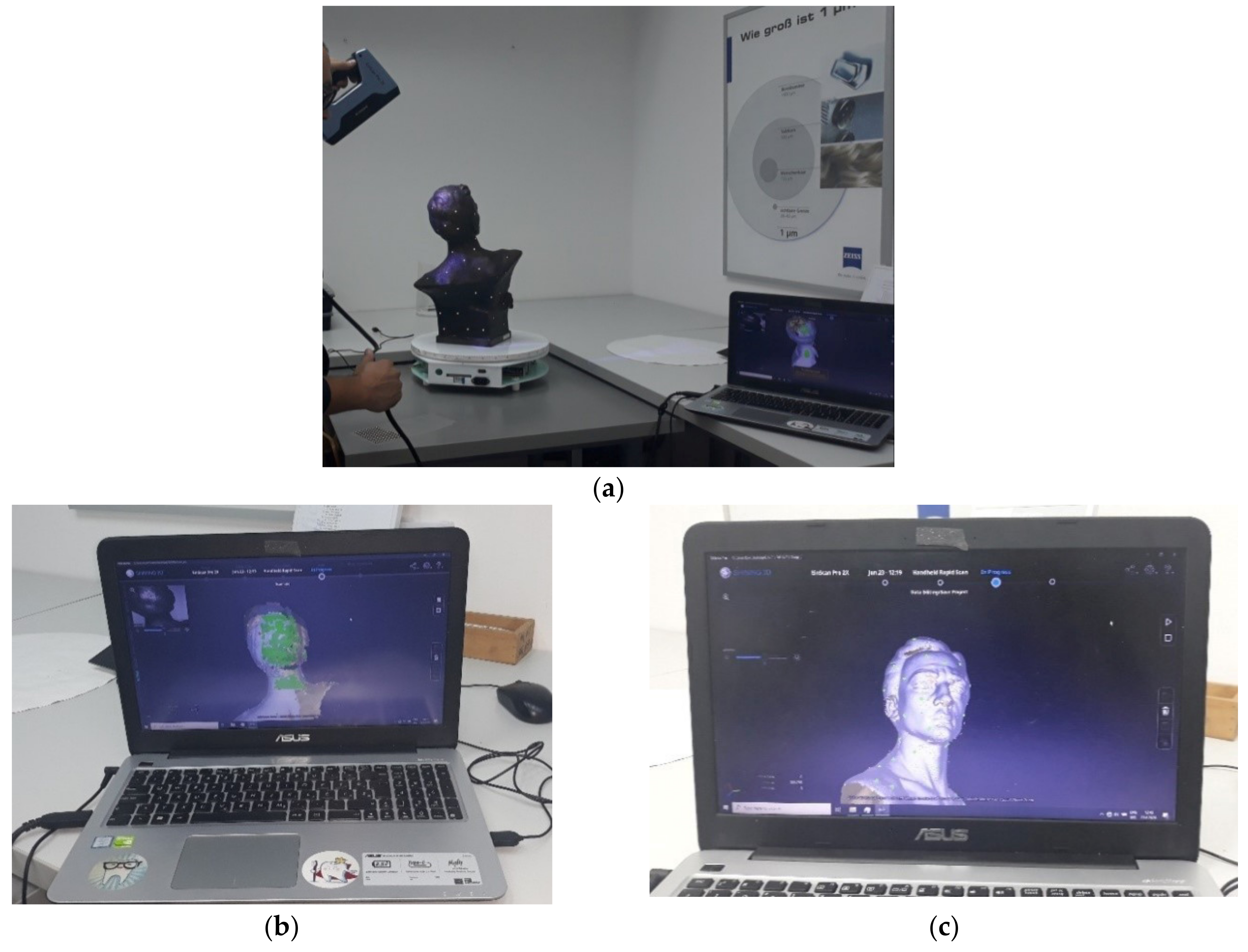
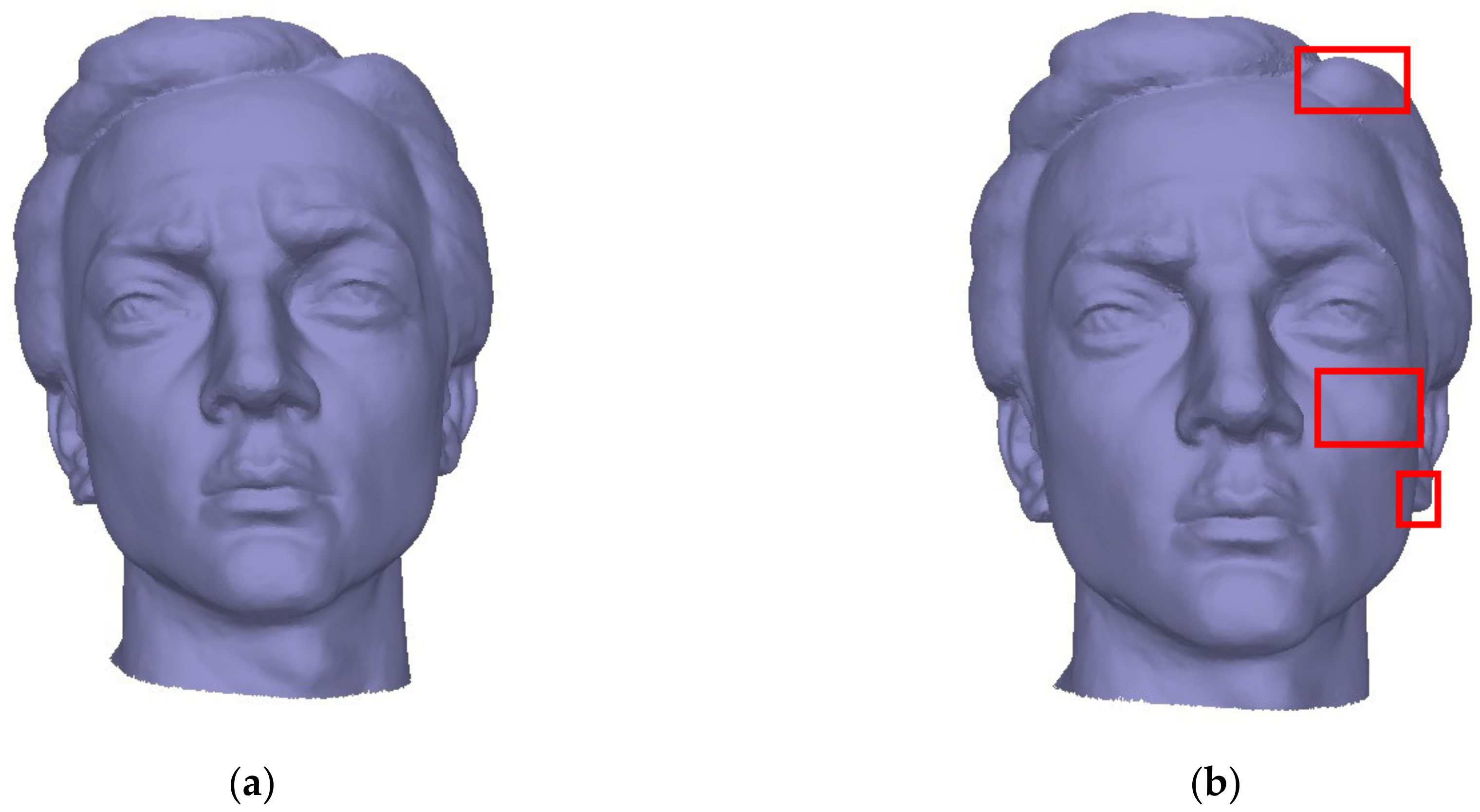

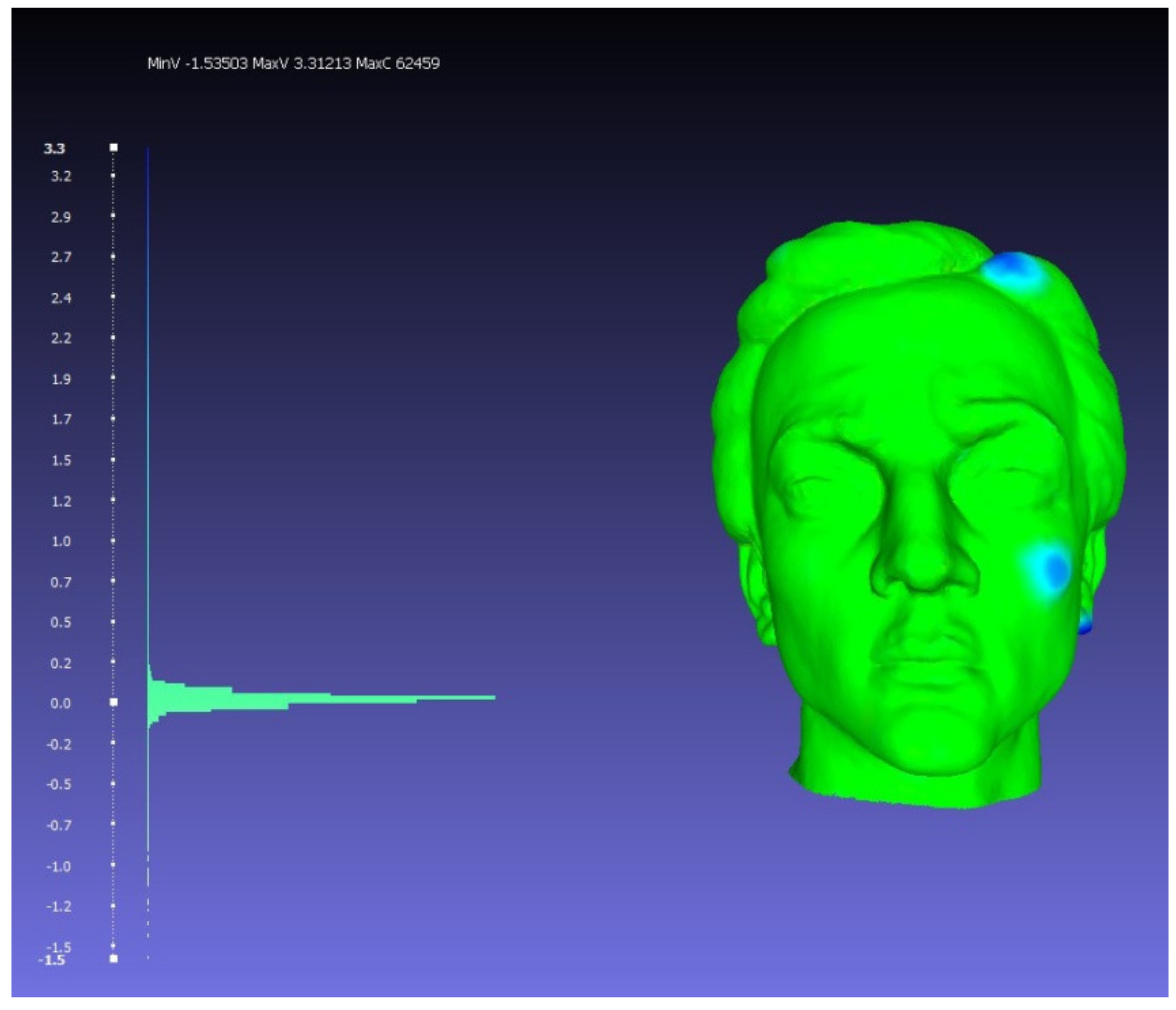


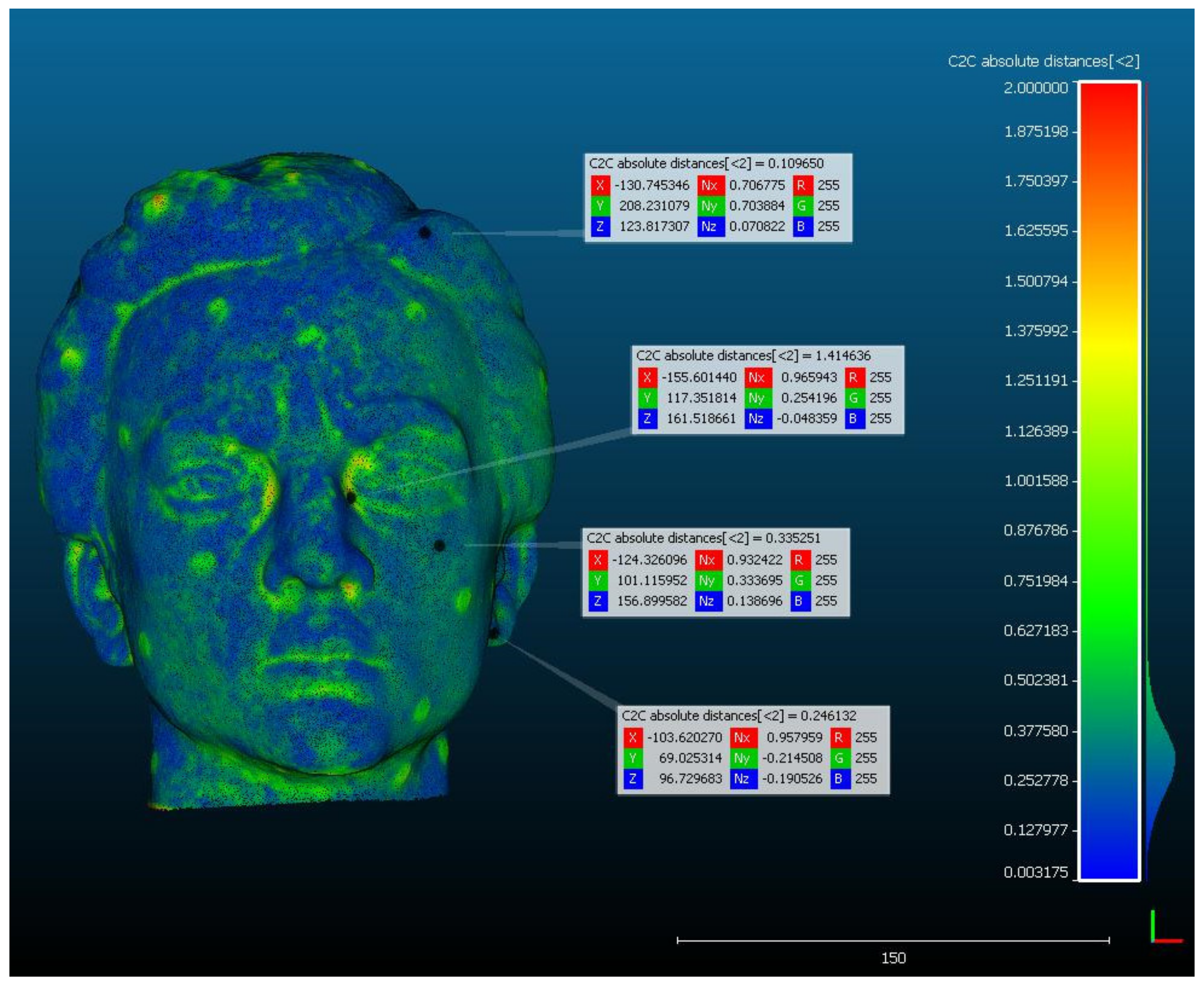



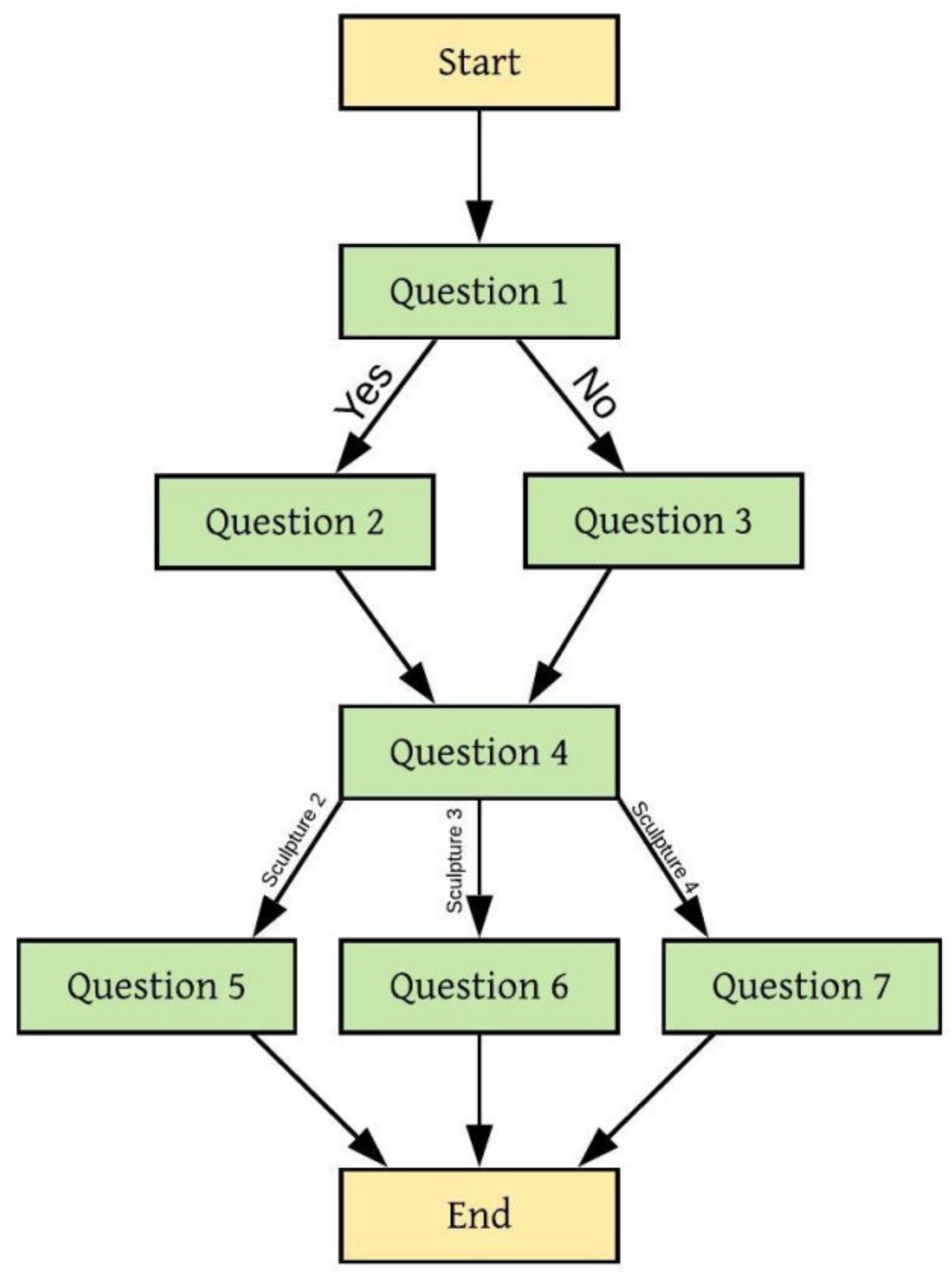


| Surveying Parameters | Original Sculpture and Sculpture with Clay Details |
|---|---|
| GSD | 0.1 mm |
| D | 0.33 m |
| h | 0.5 m |
| b | 0.19 m |
| Focal length (c) | 35 mm |
| Focus point | 0.7 m |
| f-stop | f/11 |
| ISO speed | 100 |
| Exposure time | 1/2 s |
| Group | Number of Respondents | Question 2 (Answer: Sculptures 1 and 4) | Question 3 (Answer: Sculptures 1 and 4) | Question 5 (Answer: Sculpture 2) | Question 6 (Answer: Sculpture 3) | Question 7 (Answer: Sculpture 4) |
|---|---|---|---|---|---|---|
| I year | 16 | 0 | 9 | 1 | 15 | 0 |
| II year | 22 | 3 | 11 | 6 | 19 | 0 |
| III year | 18 | 2 | 11 | 3 | 17 | 1 |
| IV year | 30 | 3 | 20 | 4 | 28 | 0 |
| V year (master) | 8 | 1 | 7 | 2 | 7 | 0 |
| I year (ME) | 72 | 6 | 43 | 4 | 66 | 4 |
| Others | 29 | 4 | 19 | 3 | 24 | 4 |
Publisher’s Note: MDPI stays neutral with regard to jurisdictional claims in published maps and institutional affiliations. |
© 2021 by the authors. Licensee MDPI, Basel, Switzerland. This article is an open access article distributed under the terms and conditions of the Creative Commons Attribution (CC BY) license (https://creativecommons.org/licenses/by/4.0/).
Share and Cite
Vasiljević, I.; Obradović, R.; Đurić, I.; Popkonstantinović, B.; Budak, I.; Kulić, L.; Milojević, Z. Copyright Protection of 3D Digitized Artistic Sculptures by Adding Unique Local Inconspicuous Errors by Sculptors. Appl. Sci. 2021, 11, 7481. https://doi.org/10.3390/app11167481
Vasiljević I, Obradović R, Đurić I, Popkonstantinović B, Budak I, Kulić L, Milojević Z. Copyright Protection of 3D Digitized Artistic Sculptures by Adding Unique Local Inconspicuous Errors by Sculptors. Applied Sciences. 2021; 11(16):7481. https://doi.org/10.3390/app11167481
Chicago/Turabian StyleVasiljević, Ivana, Ratko Obradović, Isidora Đurić, Branislav Popkonstantinović, Igor Budak, Luka Kulić, and Zoran Milojević. 2021. "Copyright Protection of 3D Digitized Artistic Sculptures by Adding Unique Local Inconspicuous Errors by Sculptors" Applied Sciences 11, no. 16: 7481. https://doi.org/10.3390/app11167481
APA StyleVasiljević, I., Obradović, R., Đurić, I., Popkonstantinović, B., Budak, I., Kulić, L., & Milojević, Z. (2021). Copyright Protection of 3D Digitized Artistic Sculptures by Adding Unique Local Inconspicuous Errors by Sculptors. Applied Sciences, 11(16), 7481. https://doi.org/10.3390/app11167481







